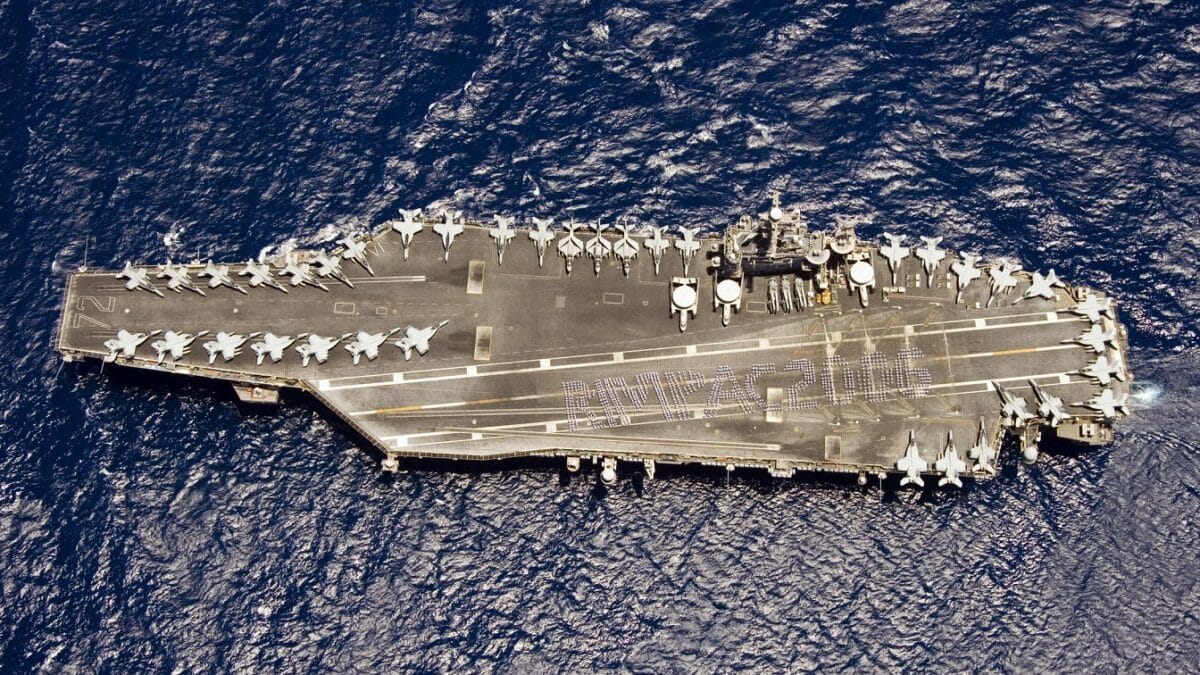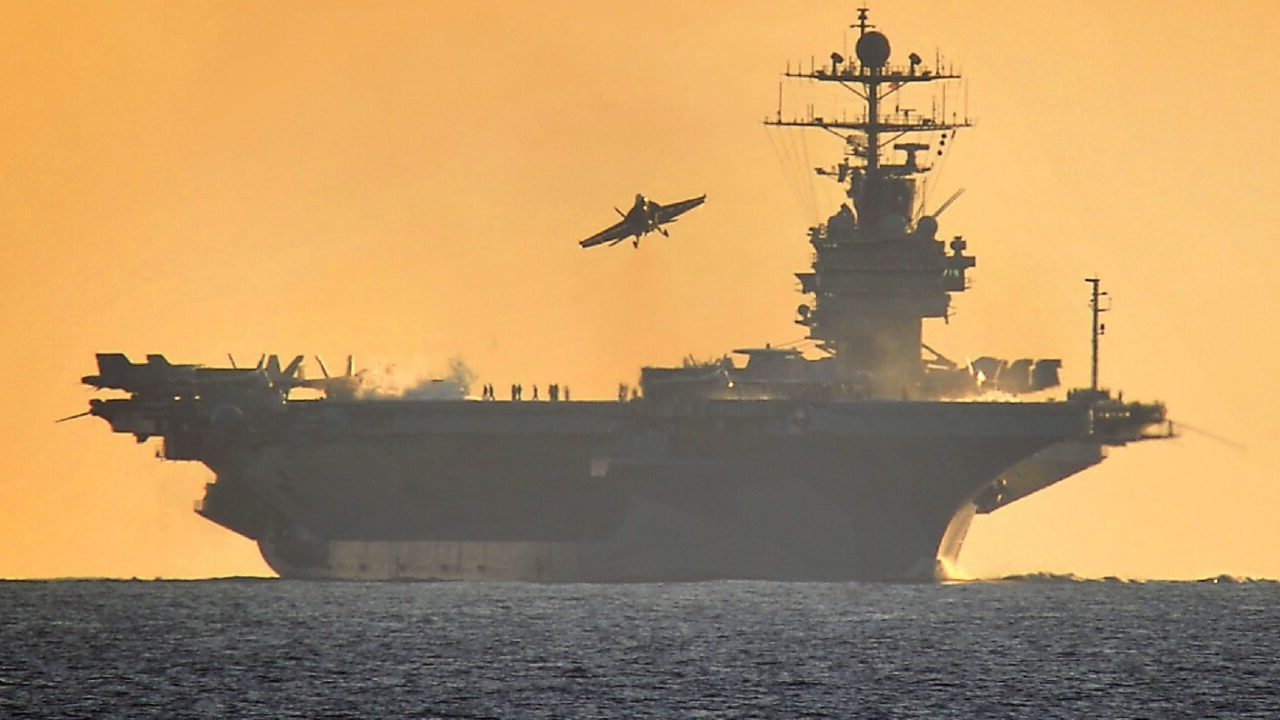While the Ford-class is coming soon, for now, the Nimitz-class is the best aircraft carrier on Earth. Here’s why: On August 28, The USS George H.W. Bush, a Nimitz-class aircraft carrier, turned over with the USS Harry Truman, taking up responsibilities with the US 6th Fleet in Europe. On this deployment the carrier, along with its surface combatants and embarked air wing, will serve as a tangible reminder of America’s naval power; acting as a deterrent to would-be aggressors and serving as a symbol of support to her allies. This is a role aircraft carriers have filled in the days since the Second World War.
The carriers of today, however, hardly resemble those that fought at the Coral Sea and Midway. At nearly four times the displacement and several hundred feet long, the modern nuclear-powered carrier is a technological marvel with capabilities far beyond those of its predecessors.
Meet the Nimitz-Class
At 1,092 feet long and with a beam of 292 feet, the Nimitz-class are true behemoths, boasting a massive flight deck over six acres in area.
First developed in the 1960’s, it is currently the backbone of the Navy’s carrier forces, making up 10 of 11 commissioned carriers, with the 11th being the brand new Gerald Ford, first in its class.
The Nimitz was designed with increased protection and better defensive armaments to replace the aging Kitty Hawk class and USS Enterprise, the latter being the first nuclear-powered carrier in the fleet.
Nuclear Power
Nuclear power proved to be a huge advantage, allowing the carrier to stay at sea for months at a time without having to refuel and generate power for propulsion as well as electricity.
Using lessons learned from the development of the Enterprise as well as an increase in general knowledge, designers of the Nimitz were able to reduce the nuclear reactors from the eight used by the Enterprise down to just two. This freed up a substantial amount of space for fuel and stores while reducing weight. The two A4W reactors drive four propeller shafts with a maximum of 260,000 horsepower.
This massive amount of power plows the carrier through the water at over 30 knots (35 mph); the actual top speed is classified. That is incredible consider the size of these warships.
Nimitz-Class: Built for War
Under normal circumstances, aircraft launching from runways on land have long runways with plenty of room to build up the speed required for flight. While 1,092 is quite long for a ship, it is not nearly the length required for a fully loaded F/A-18 weighing 66,000 pounds. The carrier circumvents the need for a long runway with a steam catapult. In a steam catapult, the reactors heat water into highly pressurized steam. Once the pressure has built to a sufficient amount, it is released, driving a shuttle along a track in the deck. The aircraft is hooked to this shuttle, accelerating to launch speeds in two to four seconds.

060725-N-7981E-170 (Jul. 25, 2006)
Aerial overhead view of US Navy (USN) Sailors aboard the USN Nimitz Class Aircraft Carrier USS ABRAHAM LINCOLN (CVN 72) spelling out RIMPAC 2006 on the flight deck of the ship during a photo exercise during Exercise Rim of the Pacific (RIMPAC) 2006 in the Pacific Ocean (POC). The exercise is designed to increase the tactical proficiency of participating units in a wide array of combined sea operations. RIMPAC 2006 brings together military forces from Australia (AUS), Canada (CAN), Chile (CHL), Peru (PER), Japan (JPN), the Republic of Korea (KOR), United Kingdom (UK) and the United States (US).
U.S. Navy photo by Mass Communication Specialist Seaman James R. Evans (RELEASED)
The speed from the catapult alone, however, is not enough to launch an aircraft; that’s where the carrier’s high speed comes into play. By steaming upwards of 30 knots, the carrier can generate a relative headwind along its flight deck, even if the winds are calm. This headwind, coupled with the steam catapult, provides enough lift over the wings to launch heavy aircraft from a short flight deck.
The steam catapult makes up one-half of the CATOBAR system employed by Nimitz-class carriers, the other half being the arresting gear used to recover or “trap” aircraft on landing. On recovery, the aircraft deploy a hook to catch a wire strung across the carrier’s deck. When the hook engages the wire, steam pressure from the reactor dampens the force of the aircraft pulling the wire. Coupled with an angled flight deck and unique lights to help the pilot stay on the appropriate glide path to the wires, carrier landings have become much more reliable.

U.S. Navy sailors view the aircraft carrier USS Carl Vinson (CVN-70) from the hangar bay of the aircraft carrier USS Theodore Roosevelt (CVN-71). Theodore Roosevelt was deployed in the U.S. 5th Fleet area of responsibility supporting Operation Inherent Resolve, strike operations in Iraq and Syria as directed, maritime security operations and theater security cooperation efforts in the region.
What Makes the Nimitz-Class Special
For decades, the Nimitz-class carriers have been the sole carrier in the US Navy. In 2017, however, the USS Gerald R. Ford was commissioned as first in a new class of carriers. Based on the Bush, which had many upgrades over the Nimitz, the Ford is the next generation of American carrier. With improved electronic and radar systems, an updated design, and new technology such as the Electromagnetic Aircraft Launch System (EMALS), the Ford is set to meet the challenges of the coming decades as she represents the Navy and America on the seas.
Maya Carlin is a Middle East Defense Editor with 19FortyFive. She is also an analyst with the Center for Security Policy and a former Anna Sobol Levy Fellow at IDC Herzliya in Israel. She has by-lines in many publications, including The National Interest, Jerusalem Post, and Times of Israel.

